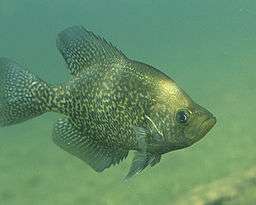Crappie
| Crappies | |
|---|---|
 | |
| Black (top) and white crappie (P. nigromaculatus & P. annularis) | |
| Scientific classification | |
| Kingdom: | Animalia |
| Phylum: | Chordata |
| Class: | Actinopterygii |
| Order: | Perciformes |
| Family: | Centrarchidae |
| Genus: | Pomoxis Rafinesque, 1818 |
| Type species | |
| Pomoxis annularis Rafinesque, 1818 | |
The crappies (/ˈkræpiː/ or /ˈkrɒpiː/)[1][2] are a genus, Pomoxis, of North American freshwater fish in the sunfish family Centrarchidae. Both species in this genus are popular game fish.
Etymology
The genus name Pomoxis derives from the Greek πώμα (cover, plug, operculum) and οξύς (sharp). The common name (also spelled croppie or crappé), derives from the Canadian French crapet, which refers to many different fishes of the sunfish family. Other names for crappie are papermouths, strawberry bass, speckled bass or specks (especially in Michigan), speckled perch, crappie bass, calico bass, (throughout the Middle Atlantic states, and New England),[3] sac-a-lait (in southern Louisiana, lit. "milk bag", an alteration by folk etymology from Choctaw sakli)[4] and Oswego bass.
Species
The currently recognized species in this genus are:[5]
- White crappie – P. annularis Rafinesque, 1818
- Black crappie – P. nigromaculatus (Lesueur, 1829)
Biology
Both species of crappie as adults feed predominantly on smaller species, including the young of their own predators (which include the northern pike, muskellunge, and walleye). They have diverse diets, however, including zooplankton, insects, and crustaceans.[6][7] By day, crappie tend to be less active and will concentrate around weed beds or submerged objects, such as logs and boulders. They feed during dawn and dusk, by moving into open water or approaching the shore.[8][9]
Fishing

The Pomoxis species are highly regarded game fish and are often considered to be among the best-tasting freshwater fish. Because of their diverse diets, crappie may be caught in many ways, including casting light jigs, trolling with minnows or artificial lures, using small spinnerbaits, or using bobbers. Crappies are also popular with ice-fishers, as they are active in winter.[8][9][10] The current all-tackle fishing world record for a black crappie is 2.25 kg (5.0 lb) and for a white crappie is 2.35 kg (5.2 lb).[11][12]
Angling
| Fly fishing |
|---|
| |
| targets |
| bluefish |
| brook trout |
| crappie |
| hucho taimen |
| largemouth bass |
| northern pike |
| peacock bass |
| shoal bass |
| smallmouth bass |
| more fly fish... |
| other sport fish... |
|
|
| fishing |
|
|
| I N D E X |
Angling for crappie is popular throughout much of North America. Methods vary, but among the most popular is called "Spider Rigging," a method characterized by a fisherman in a boat with many long fishing rods pointing away from the angler at various angles like spokes from a wheel.[13] Anglers who employ the Spider Rigging method may choose from among many popular baits. Some of the most popular are plastic jigs with lead jig heads, crankbaits or live minnows.[14] Many anglers also chum or dump live bait into the water to attract the fish to bite their bait. Crappies are also regularly targeted and caught during the spawning period by fly fishermen, and can be taken from frozen ponds and lakes in winter by ice fishing.
Commercial fishing
A commercial fishery for crappies existed at Reelfoot Lake in Tennessee until 2003. It was one of the few commercial fisheries for crappies.
Crappie fishing records
By information from International Game Fish Association IGFA the most outstanding records:[15]
- Black crappie is a 5-pound fish caught April 21, 2005, by John R. Horstman from a private lake in Missouri. USA on April 21, 2006 that weighted 2.26 kg (5 lbs. 0 oz.)
- White crappie is a 5-pound fish caught July 31, 1957, by Fred Brigh in Mississippi. USA on July 31, 1957 that weighted 2.35 kg (5 lbs, 3 oz.)
References
- ↑ "Crappie". American Heritage Dictionary (4th ed.). Retrieved 2006-06-29.
- ↑ "Crappie". Merriam-Webster Online Dictionary. Retrieved 2006-06-29.
- ↑ Massachusetts Wildlife
- ↑ Sac-a-lait or Crappie at www.thejump.net
- ↑ Froese, Rainer, and Daniel Pauly, eds. (2013). Species of Pomoxis in FishBase. February 2013 version.
- ↑ Froese, Rainer and Pauly, Daniel, eds. (2006). "Pomoxis annularis" in FishBase. March 2006 version.
- ↑ Froese, Rainer and Pauly, Daniel, eds. (2006). "Pomoxis nigromaculatus" in FishBase. March 2006 version.
- 1 2 "Comprehensive Report Species – Pomoxis annularis". NatureServe Explorer. Retrieved 2006-06-29.
- 1 2 "Comprehensive Report Species – Pomoxis nigromaculatus". NatureServe Explorer. Retrieved 2006-06-29.
- ↑ "Black Crappie". Florida Museum of Natural History Ichthyology Department. Retrieved 2006-06-29.
- ↑ IGFA World Record: Black Crappie – (Pomoxis nigromaculatus)
- ↑ IGFA World Record: White Crappie – (Pomoxis annularis)
- ↑ "Super Crappie Systems". In-Fisherman. Archived from the original on 22 December 2006. Retrieved 23 February 2007.
- ↑ Crappie Fishing Educational Fishing Information for Crappie. Retrieved 2013-07-24
- ↑ "IGFA World Records". International Game Fish Association. Retrieved November 1, 2015.
Further reading
- "Pomoxis". Integrated Taxonomic Information System. Retrieved 29 June 2006.
- Ellis, Jack (1993). The Sunfishes-A Fly Fishing Journey of Discovery. Bennington, VT: Abenaki Publishers, Inc. ISBN 0-936644-17-6.
- Rice, F. Philip (1964). America's Favorite Fishing: A Complete Guide to Angling for Panfish. New York: Harper Row.
- Rice, F. Philip (1984). Panfishing. New York: Stackpole Books. ISBN 0-943822-25-4.
- Malo, John (1981). Fly-Fishing for Panfish. Minneapolis, Minnesota: Dillon Press Inc. ISBN 0-87518-208-9.
| Wikimedia Commons has media related to Pomoxis. |